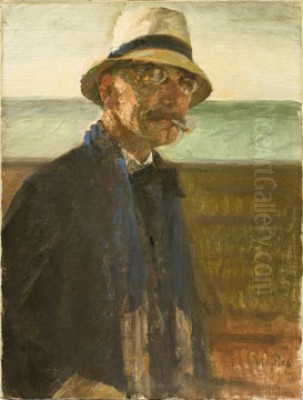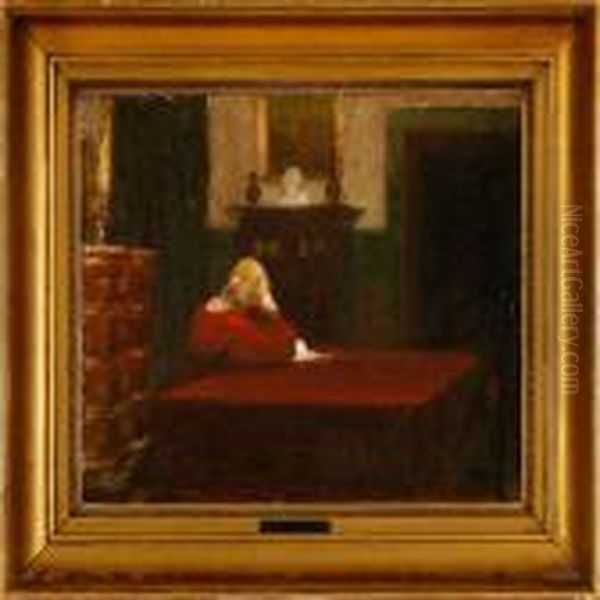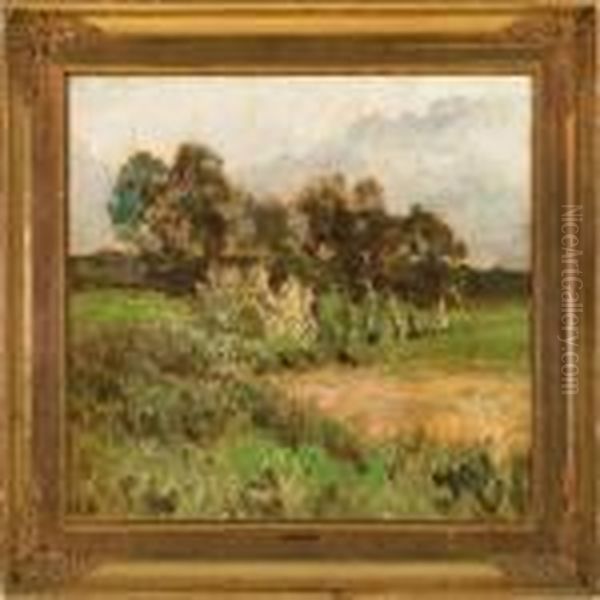
Julius Paulsen stands as a significant yet sometimes overlooked figure in the rich tapestry of Danish art history. Born in Odense, Denmark, on October 22, 1860, and passing away in Copenhagen on February 17, 1940, his life spanned a period of profound artistic transformation in Europe. Paulsen navigated this era with a unique sensibility, creating a body of work that defies easy categorization, blending elements of Realism, Symbolism, and Impressionism into a distinctive personal style. He is particularly celebrated for his evocative portraits and atmospheric landscapes, which often possess a quiet intensity and psychological depth.
Paulsen's journey as an artist began formally at the prestigious Royal Danish Academy of Fine Arts (Det Kongelige Danske Kunstakademi) in Copenhagen, where he studied from 1879 to 1882. This institution, shaped by the legacy of the Danish Golden Age and figures like Christoffer Wilhelm Eckersberg, provided a solid foundation in traditional techniques. However, Paulsen was not content to merely replicate the past. His artistic curiosity led him to absorb contemporary currents, positioning him as a crucial transitional figure connecting the established Naturalism of the 19th century with the burgeoning Symbolist movement of the early 20th century in Denmark.
Early Life and Academic Foundations
Julius Paulsen's origins were relatively modest; his father was a shopkeeper in Odense, a city known for being the birthplace of Hans Christian Andersen. This background perhaps instilled in him a grounded perspective, even as his artistic talents propelled him towards the cultural center of Copenhagen. His decision to pursue art led him to the Royal Danish Academy, the cornerstone of artistic training in the country. The Academy at that time was still grappling with the heritage of the Golden Age painters while simultaneously responding to the wave of Realism sweeping across Europe.

During his years at the Academy (1879-1882), Paulsen would have been immersed in rigorous training focused on drawing, anatomy, and composition, following academic traditions. This classical grounding is evident in the structure and technical proficiency of his later works. However, the seeds of his individual style were already being sown, as he began to look beyond purely objective representation towards capturing mood, atmosphere, and the inner life of his subjects. His time at the Academy provided the technical tools he would later adapt and transform to suit his unique artistic vision.
Influences and Artistic Synthesis
Paulsen's artistic development was marked by a remarkable ability to synthesize diverse influences. He held a deep admiration for the Old Masters, particularly the Dutch Golden Age painters. The profound psychological insight and dramatic use of light and shadow (chiaroscuro) found in the works of Rembrandt van Rijn clearly resonated with Paulsen, echoing in the depth and introspection of his own portraits. Similarly, the quiet intimacy and masterful handling of light in domestic scenes by Johannes Vermeer can be seen as an inspiration for Paulsen's subtle modulations of tone and atmosphere.
Beyond the Dutch Masters like Rembrandt and Vermeer, and potentially Frans Hals, Paulsen also absorbed lessons from French art. He was aware of the technical polish and narrative clarity often found in French Salon painting, associated with artists like Jean-Léon Gérôme or William-Adolphe Bouguereau, even if his own path diverged significantly from their academicism. More crucially, he engaged with the revolutionary ideas of Impressionism. While not strictly an Impressionist himself, he adopted aspects of their approach to light and color, using looser brushwork at times to capture fleeting effects and sensory experiences, akin to the explorations of Claude Monet or Pierre-Auguste Renoir.
This eclectic mix of influences allowed Paulsen to forge a style that was both rooted in tradition and responsive to modern developments. He skillfully combined classical compositional structures and a respect for accurate drawing with a more modern sensitivity to light, color, and subjective experience. This synthesis made him a pivotal figure, bridging the gap between the detailed Naturalism prevalent in Denmark in the mid-to-late 19th century and the more inward-looking, suggestive art of Symbolism that gained traction around the turn of the century, represented by contemporaries like Vilhelm Hammershøi and J.F. Willumsen.
Style, Themes, and Techniques

The hallmark of Julius Paulsen's art lies in its atmospheric quality and psychological resonance. He excelled at creating mood through subtle means, often employing a muted palette and soft, diffused light. His brushwork could range from relatively tight and descriptive to more broken and suggestive, always serving the overall emotional tone of the piece. He was less interested in dramatic action or precise topographical detail than in capturing the intangible essence of a person or a place.
In his portraiture, Paulsen sought to penetrate beyond mere physical likeness to reveal the inner spirit or emotional state of the sitter. His subjects often appear contemplative or introspective, rendered with a sensitivity that invites empathy from the viewer. He used light not just to model form but to create a specific ambiance, often enveloping his figures in a soft glow or placing them in subtly lit interiors that enhance the sense of quietude or reflection. This focus on psychological depth connects his work to the broader Symbolist interest in exploring the unseen realms of thought and feeling.
His landscapes share this evocative quality. Rather than depicting grand vistas, Paulsen often focused on more intimate scenes: a misty harbor, a rain-swept grove of trees, the quiet light of dusk over fields. He was particularly adept at rendering the specific light and weather conditions of the Danish environment, capturing the nuances of grey skies, damp earth, and the soft greens and browns of the Nordic landscape. These works are not just records of places but are imbued with feeling, often conveying a sense of melancholy, peace, or gentle solitude. His technique involved building up layers of color and tone to achieve a rich, vibrating surface that enhances the atmospheric effect.
Major Works and Recognition
Throughout his career, Julius Paulsen created several works that cemented his reputation. An early significant piece often cited is Adam og Eva (Adam and Eve) from 1887. This work, depicting the biblical figures after the Fall, showcased his ability to handle complex figure compositions and convey deep emotion, marking him as a talent to watch. It demonstrated his engagement with traditional themes but interpreted through a more modern, psychologically attuned lens. Another notable work sometimes mentioned is Kain (Cain), further exploring themes of guilt and inner turmoil.

Paulsen was also a highly sought-after portraitist. His portrait of fellow artist P.S. Krøyer, a leading figure among the Skagen Painters, is a sensitive portrayal capturing the personality of his famous contemporary. Another significant commission was the group portrait of the family of Laurits Tuxen, another prominent Skagen painter and professor. These portraits highlight his skill in capturing not just individual likenesses but also the dynamics within a group. His painting Ung pariserinde danser Carmen (Young Woman from Paris Dancing Carmen) shows a different facet, exploring movement and cultural themes with his characteristic atmospheric handling.
Paulsen's achievements did not go unnoticed. He received several prestigious awards during his lifetime, affirming his standing within the Danish art establishment. These included the Hielmstierne-Rosencrenske Prize and the Neuhausenske Præmier (Neuhausen Prize), both significant accolades in the Danish art world. Perhaps the most distinguished honor was the Thorvaldsen Medal, awarded by the Royal Danish Academy of Fine Arts in recognition of his artistic contributions. This medal, named after the celebrated neoclassical sculptor Bertel Thorvaldsen, is the highest honor the Academy bestows upon an artist. These awards underscored the respect he commanded from his peers and institutions.
His works found their way into important collections. Today, paintings by Julius Paulsen are held in major Danish museums, including the Statens Museum for Kunst (National Gallery of Denmark) in Copenhagen and The Museum of National History at Frederiksborg Palace, which houses significant portrait collections. His recognition extended beyond Denmark, with works also held internationally, for instance, in the collection of the Musée d'Orsay in Paris, testament to his broader European relevance.
Connections to the Skagen Painters
Julius Paulsen maintained connections with the vibrant artistic community known as the Skagen Painters, although his style often differed from the group's more characteristic Naturalist and Impressionist depictions of fishermen and sunlit social gatherings. Skagen, a remote fishing village at the northernmost tip of Jutland, attracted numerous Scandinavian artists from the 1870s onwards, drawn by its unique light and picturesque motifs. Key figures included P.S. Krøyer, Michael Ancher, Anna Ancher, Laurits Tuxen, Viggo Johansen, and the Norwegian Christian Krohg.
Paulsen is known to have visited Skagen on several occasions, particularly in the early years of the 20th century. His friendships with Krøyer and Tuxen, evidenced by his portraits of them, placed him within their circle. However, Paulsen's artistic temperament leaned more towards introspection and Symbolist undertones than the often brighter, more extroverted scenes favored by many Skagen painters like Krøyer or the Anchers. While they masterfully captured the external effects of Skagen's light, Paulsen seemed more focused on the internal landscapes of his subjects or the subtle moods of nature.

His connection to Skagen thus represents an interesting intersection. He participated in the milieu and shared friendships with its core members, yet maintained his distinct artistic identity. His Skagen-related works, while perhaps less numerous than those of the dedicated colony members, likely absorbed some of the atmosphere of the place while filtering it through his own unique sensibility, perhaps focusing more on the quieter, more melancholic aspects of the coastal environment rather than its sunny social life. His relationship with the group underscores the interconnectedness of the Danish art scene at the time, even among artists with differing stylistic inclinations.
Teaching Career and Later Life
Beyond his own artistic production, Julius Paulsen made a significant contribution to Danish art through his role as an educator. He eventually returned to his alma mater, the Royal Danish Academy of Fine Arts, this time as a professor. He held this influential position for many years, shaping the development of subsequent generations of Danish artists. His teaching would likely have reflected his own artistic values: a respect for traditional craft combined with an encouragement towards personal expression and sensitivity to mood and atmosphere.
As a professor, Paulsen would have been a respected figure within the Academy, guiding students through the technical and conceptual challenges of painting. His own work served as an example of how to navigate the complex artistic landscape of the time, balancing classical training with modern influences. While specific names of his most prominent students are not always highlighted in general accounts, his long tenure suggests a considerable impact on the trajectory of Danish art in the early 20th century. His approach might have offered an alternative to other influential teachers like Kristian Zahrtmann, known for his more radical use of color and historical themes.
Paulsen continued to paint throughout his later years, refining his characteristic style. He remained based in Copenhagen, the hub of Danish cultural life, where he passed away in 1940 at the age of 79. By the end of his life, the art world had continued to evolve, moving towards various forms of Modernism, but Paulsen remained largely committed to his own nuanced, atmospheric vision, rooted in observation yet imbued with subjective feeling. His legacy was secured not only through his paintings but also through his dedicated service as a teacher at the heart of Denmark's artistic establishment.
Legacy and Significance

Julius Paulsen occupies a unique and important place in Danish art history. His primary significance lies in his role as a transitional figure, adeptly navigating the currents between 19th-century Naturalism and the emerging Symbolist and modern sensibilities of the early 20th century. He demonstrated that it was possible to honor the technical mastery and psychological depth of Old Masters like Rembrandt while incorporating a modern understanding of light, color, and subjective experience, influenced by Impressionism and Symbolism.
His work stands apart from some of his more famous contemporaries. While he shared the Skagen painters' interest in light and Danish motifs, his approach was generally more introspective and atmospheric than the celebratory brightness often found in the works of P.S. Krøyer. His quiet, moody interiors and landscapes find perhaps closer parallels with the work of Vilhelm Hammershøi, another Danish master of subtle light and enigmatic atmosphere, though Paulsen's style often retained a warmer palette and a more direct emotional connection compared to Hammershøi's cool detachment.
Paulsen's legacy endures through his paintings, which continue to be appreciated for their technical skill, subtle beauty, and emotional depth. His works in major Danish museums ensure his continued visibility and relevance. Furthermore, his long career as a professor at the Royal Danish Academy means his influence extended through his students, contributing to the ongoing development of Danish art. He represents a vital strand of Danish painting that valued sensitivity, introspection, and the power of atmosphere, offering a bridge between tradition and the complexities of modern artistic expression.
Conclusion
Julius Paulsen was a painter of quiet distinction. Born in Odense and educated in Copenhagen, he absorbed the lessons of the past masters like Rembrandt while engaging thoughtfully with the artistic innovations of his own time, including Impressionism and Symbolism. His portraits delve into the psychological depths of his sitters, while his landscapes capture the subtle moods and specific light of the Danish environment. Connected to influential circles like the Skagen Painters, yet maintaining his unique artistic voice, he earned respect and accolades, including the prestigious Thorvaldsen Medal. As both a prolific artist and a dedicated professor at the Royal Danish Academy, Paulsen left an indelible mark on Danish art, creating a legacy of atmospheric, emotionally resonant works that bridge the gap between 19th-century traditions and the dawn of 20th-century modernism. His paintings continue to invite viewers into a world of subtle beauty and quiet contemplation.